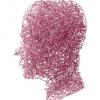I just saw this. Interesting absence of L-Glutamate. Any specific reason? PS - you're awesome
Baww. ![]()
I have tried l-glutamine in the past. Worse migraines. Makes sense since my glutamatergic system is on a hair trigger; I already have more than I need. Tyrosine was worse though, as was phenylalanine and phenylethylamine (no doubt because all of them indirectly lead to increased tyramine).
The mitochondrial support's sole purpose (in my regimen) is to help regulate NMDA - in multiple ways. So controlling extracellular glutamate (this means assisting my brain in clearing glutamate, which does not function normally), helping to keep cellular calcium channels closed, etc. Low cellular energy is a major factor here in the triggering of migraine, as is insufficient energy transport.
Here's just one example why: http://www.sciencedi...071909113000533
Mitochondrial Dysfunction in Migraine
Abstract:
Migraine is the most frequent type of headache in children. In the 1980s, scientists first hypothesized a connection between migraine and mitochondrial (mt) disorders. More recent studies have suggested that at least some subtypes of migraine may be related to a mt defect. Different types of evidence support a relationship between mitochondria (mt) and migraine: (1) Biochemical evidence: Abnormal mt function translates into high intracellular penetration of Ca2+, excessive production of free radicals, and deficient oxidative phosphorylation, which ultimately causes energy failure in neurons and astrocytes, thus triggering migraine mechanisms, including spreading depression. The mt markers of these events are low activity of superoxide dismutase, activation of cytochrome-c oxidase and nitric oxide, high levels of lactate and pyruvate, and low ratios of phosphocreatine-inorganic phosphate and N-acetylaspartate-choline. (2) Morphologic evidence: mt abnormalities have been shown in migraine sufferers, the most characteristic ones being direct observation in muscle biopsy of ragged red and cytochrome-c oxidase-negative fibers, accumulation of subsarcolemmal mt, and demonstration of giant mt with paracrystalline inclusions. (3) Genetic evidence: Recent studies have identified specific mutations responsible for migraine susceptibility. However, the investigation of the mtDNA mutations found in classic mt disorders (mt encephalomyopathy with lactic acidosis and stroke-like episodes, myoclonus epilepsy with ragged red fibers, Kearns-Sayre syndrome, and Leber hereditary optic neuropathy) has not demonstrated any association. Recently, 2 common mtDNA polymorphisms (16519C→T and 3010G→A) have been associated with pediatric cyclic vomiting syndrome and migraine. Also, POLG mutations (eg, p.T851 A, p.N468D, p.Y831C, p.G517V, and p.P163S) can cause disease through impaired replication of mtDNA, including migraine. Further studies to investigate the relationship between mtDNA and migraine will require very large sample sizes to obtain statistically significant results. (4) Therapeutic evidence: Several agents that have a positive effect on mt metabolism have shown to be effective in the treatment of migraines. The agents include riboflavin (B2), coenzyme Q10, magnesium, niacin, carnitine, topiramate, and lipoic acid. Further study is warranted to learn how mt interact with other factors to cause migraines. This will facilitate the development of new and more specific treatments that will reduce the frequency or severity or both of this disease.
Introduction
Headaches are very common during childhood and become increasingly more frequent during the teenage years. By 7 years of age, 37%-52% of individuals have headaches. In 7-15 year olds, headache prevalence ranges from 57% to 82%. Migraine is the most frequent type of headache in children. Its prevalence at the age of 7 years ranges from 1.2% to 3.2%, and between 7 and 15 years of age, it ranges from 4% to 11%.1
One of the primary symptoms of mitochondrial (mt) disease is episodic head pain. Therefore, it is quite reasonable to hold the belief that mitochondria (mt) may play a role in the pathogenesis of headache, particularly migraine. Recent epidemiologic studies have found that mtDNA-related disease is quite common with a prevalence of 1 in 5000 persons. The population frequency of the 10 most common pathogenic mtDNA mutations is much higher, approximately 1 in 200, suggesting that otherwise normal individuals may carry potentially harmful mtDNA mutations that are of little clinical significance until the body is stressed. The true coincidence of mt disease with migraine is under investigation.2; 3 ; 4
Mt are small organelles that play a central role in a variety of cellular functions, including energy generation, reactive oxygen species (ROS) production, regulation of apoptosis, and control of Ca2+ homeostasis.2 Their function is of paramount importance in high-energy consuming organs like the brain, heart, liver, and muscle. When there is a failure of function, symptoms that may initially appear to localize to that organ arise. Therefore, mt dysfunction has been associated with a variety of symptoms and signs, depending on the affected organ systems.2
Although advances have been made in the study of the genetic and biochemical mechanisms of migraine pathophysiology, they are still not fully understood. In the 1980s, scientists first published evidence and hypothesized a connection between migraine and mt disorders.3 More recent evidence has suggested that at least some subtypes of migraine may be related to a mt defect.2; 4 ; 5
Regarding the cause and nature of migraine, 2 opposing theories have been postulated: vascular and neuronal dysfunction.4 ; 6 The vascular theory of migraine pathogenesis states that cerebral and meningeal arteries are activated, causing brief vasoconstriction followed by vasodilatation with increased cerebral blood flow and extravasation of proinflammatory neuropeptides from leaky blood vessels. Ultimately, this process stretches out the end terminals of the nerves in the wall of the blood vessels, causing activation of the trigeminal system and pain.6 There is strong evidence that migraine pathophysiology is caused by neuronal dysfunction. Leao7 proposed that cortical spreading depression (CSD) activates the trigeminal nerves and causes the migraine attacks. CSD is a wave of neuronal and glial depolarization or neuronal hyperexcitability followed by a long-lasting suppression of neuronal activity.4 ; 7 Both of these mechanisms have been associated with mt dysfunction, impairing mt oxidative metabolism, interrupting proper nervous system functioning, and therefore, affecting migraine susceptibility.4
The objective of this paper is to review the current biochemical, morphologic, genetic, and therapeutic evidence that may explain the pathogenesis of mt-related migraine.
Mitochondria and Migraine Relationship: Biochemical Evidence
Mt play an integral role in controlling vascular tone by stabilizing the concentrations of intracellular Ca2+ and ROS. Nitric oxide (NO), a potent vasodilator, has been implicated in this process. Cytochrome-c oxidase (COX), also known as complex IV of the mt respiratory transport chain, has been shown to bind NO.7 In vessels that are rich with COX, there may be sequestration of NO, which prevents vasodilatation, for example, during stroke episodes in patients with mt encephalopathy with lactic acidosis and strokes (MELAS).8
Intravascular platelet dysfunction can lead to altered vascular mechanics, for example, deficits of nicotinamide adenine dinucleotide phosphate (NADH)-dehydrogenase, COX, and citrate synthetase. Sangiorgi et al9 evaluated the platelet mt enzyme activity in patients with migraine, with or without aura. They found impairment in NADH dehydrogenase, citrate synthetase, and COX in the migraineurs. In another study, patients with migraine with aura had lower platelet levels of superoxide dismutase, a mt-derived enzyme, in their platelets compared with those of control subjects, suggesting vulnerability to oxidative stress (OS).10
Neurotransmitter turnover and nerve cell membrane stabilization are both energy-intensive processes, and both have a vital effect on the origination of CSD. During energy failure, tyrosine shifts to decarboxylase enzyme activity, creating more of the neuromodulators tyramine, octopamine, and synephrine associated with a decrease in norepinephrine.11 Levels of trace amines, such as tyramine, octopamine, and synephrine, are increased in the platelets of patients with migraine.12 In addition, the recycling of free radicals, which is a mt-dependent process, has also been implicated in migraine. Iron ions have been shown to accumulate in the brain stem of patients with migraine, more so among patients with chronic migraine with daily attacks of headache.13
As neuronal energy production diminishes, the cell will eventually loose regulatory control and die. This can be clearly seen in the brain stem necrosis noted in one of the most severe mt disorders, Leigh syndrome. N-acetylaspartate (NAA) is considered a marker of neuronal integrity and has been shown to be associated with migraine. NAA is produced exclusively in neuronal mt, enters the bloodstream, and is excreted through the kidney. The earliest studies discovered that low NAA levels are associated with neuronal loss in the brain.14 In later studies, NAA levels in the brain, measured with proton magnetic resonance spectroscopy (1H-MRS), were much lower in patients with migraine than in normal control subjects.15 In addition, using1H-MRS, it has been reported that the NAA-choline ratio is reduced in the thalami of patients with migraine compared with controls.16 NAA levels are also reduced in the blood of patients with migraine compared with patients with tension-type headache and controls.17
Familial hemiplegic migraine type 1 (FHM1) is caused by a mutation in the voltage-dependent calcium channel alpha 1 gene (CACNA1A). This defect causes a deregulation of Ca2+ homeostasis and thus has been linked to CSD.18 Other studies have shown that an increased Ca2+ concentration within astrocytes causes vasoconstriction during CSD, a process that is mediated by the arachidonic acid metabolite, phospholipase A2.19 As mt are involved in Ca2+ homeostasis, a process essential for the normal functioning of neurons, it is logical that an imbalance of Ca2+ could lead to a range of downstream imbalances and as a result, an increased susceptibility to migraine.4
Peripheral pain mechanisms and their association with mt have also been studied. The mechanism of pain behaviors peripherally is enhanced by higher concentration of intracellular Ca2+ and inhibited by its lower concentration.20 The primary mechanism of Ca2+ sequestration in a cell is via the mt, and this mt dysfunction can lead to pain hypersensitization. Free-radical scavenging by mt plays a similar role in pain. Pain behavior has also been shown to decrease when levels of ROS are decreased at the spinal level.21
Phosphorus MRS (30P-MRS) is used to assess the integrity of brain energy metabolism by measuring intracellular concentration of phosphocreatine (PCr), inorganic phosphate (Pi), and adenosine diphosphate (ADP). A Pi from PCr is normally removed by mt oxidative phosphorylation (OXPHOS) and is then transferred to ADP to create adenosine triphosphate. 30P-MRS calculates intracellular concentrations of these compounds in vivo. In addition, the intracellular pH can be monitored, and it is decreased in lactic acidosis, as is seen with mt respiratory chain, or electron transport chain (ETC), dysfunction. Low PCr-Pi ratios and high levels of ADP, representing low availability of free energy, were observed in patients with migraine. 22 ; 23 These findings are similar to those found in patients with known mt defects.24
Also, cluster headache has been associated with impaired mt function. In a study by Montagna et al25 patients with cluster headache were scanned using 30P-MRS and found to have reduced PCr brain levels, increased ADP concentration, and reduced phosphorylation potential.
Lactic and pyruvic acid, markers of mt disease, have been found to be increased in migraineurs, suggesting a common link between dysfunctional OXPHOS and migraine.26 In addition, Montagna et al3 demonstrated decreased mt respiratory chain or ETC enzymes in patients with migraine, and Littlewood et al27 showed that mt enzymes monoamine oxidase and succinate dehydrogenase were reduced in platelets of patients with migraine.
Dysfunctional OXPHOS, generation of ROS, and energy failure may affect astrocytes, which play a pivotal role in the maintenance and protection of the cells in the nervous system. The role of astrocytes is to scavenge ROS and to maintain the extracellular ionic and neurotransmitter environment, both of which are energy-dependent processes.28 ; 29 Energy depletion due to mt dysfunction impairs astrocytic function, which increases the vulnerability of neurons to spreading depression.29 ; 30
Mitochondria and Migraine Relationship: Morphologic Evidence
Structural mt abnormalities in disorders such as the mt encephalomyopathies, affect mainly nonactively dividing tissues, such as the skeletal muscle and neurons. Ethical reasons have so far limited histologic and ultrastructural examination of both tissues in migraine sufferers.2
In migraine patients, mt abnormalities have been also found. The most characteristic abnormality that can be seen from direct observation of tissue muscle is ragged red fibers. Ragged red fibers are subsarcolemmal aggregates of dysfunctional mt. This histopathologic phenomenon can be seen in many of the mt diseases. It has also been reported in case studies involving some people with migraine with prolonged aura3 ; 31 and in 1 person with familial hemiplegic migraine.18 COX-negative fibers are found in most patients suffering from mt encephalomyopathies and are considered to be a histologic characteristic of the disease. COX-negative fibers with increased fat accumulation have also been seen in some patients with migraine.2
Electron microscopic studies of muscle biopsy in patients with migraine have shown clusters of giant mt with paracrystalline inclusions.3 ; 18 Additional ultrastructural changes of mt in affected individuals have also been described and may reflect alterations caused by impaired OXPHOS. In particular, accumulation of subsarcolemmal mt has been found in muscle fibers of patients with migrainous stroke.32
Mitochondria and Migraine Relationship: Genetic Evidence
Migraine headaches have a clear familial incidence.1 ; 33 During the past few years, and taking advantage of the advances in genetic techniques, an area of great research interest has been the study of the genetic basis of migraine. Recent studies have identified several possible candidate genes associated with susceptibility to migraine.34; 35 ; 36
The predilection of maternal inheritance of migraine makes a mt etiology especially intriguing.37 Mt genetic inheritance is unique in that it derives exclusively from maternal origin. Compared with nuclear DNA, mtDNA has many distinct characteristics. mtDNA is small, circular, and is especially susceptible to OS. Several proteins that are needed by mt are encoded from nuclear DNA and transported into the mt by membrane receptor proteins. Defects in mtDNA as well as nuclear DNA, which encodes for mt proteins, have been discovered to cause diseases associated with mt dysfunction, such as Leigh syndrome, mt encephalomyopathy with lactic acidosis and stroke-like episodes (MELAS), myoclonus epilepsy with ragged red fibers (MERRF), Kearns-Sayre syndrome, and Leber hereditary optic neuropathy, among others. Some of these diseases have migraine associated with their phenotype.38; 39 ; 40 Molecular genetic studies investigated the potential role of mtDNA mutations that are strongly implicated in the previously enumerated mt encephalomyopathies: MELAS mutations A3243G and T3271C, MERRF mutation G8344A, Kearns-Sayre syndrome common 4977 bp deletion, and the Leber hereditary optic neuropathy mutations.4 ; 32 No significant associations were found in any of these studies, but the largest patient sample size used was only 47.
Several hypotheses may be used to explain the negative results of most mt genetic investigations in migraineurs: (1) Mutated mtDNAs may be absent or present in undetectable amounts in blood samples. (2) Migraine could be associated with mtDNA mutations that are yet to be identified. (3) Migraine may be caused by mutations in nuclear genes, which may directly affect the energy production of the mt system. It could also be related to a mutation of nuclear DNA-encoded factors involved in the posttranscriptional or posttranslational regulation or both of mtDNA expression.2
Cluster headache has also been shown to have an increased incidence in families, suggesting a genetic cause in some patients. However, there has been only a single case report of a mtDNA genetic defect being associated with cluster headache.41 On the contrary, in a series of 22 patients with cluster headache none of them carried the same mutation, indicating that such finding could be isolated.42
Two common mtDNA polymorphisms (16519C→T and 3010G→A) have been associated with pediatric cyclic vomiting syndrome and migraine.43 The nuclear POLG gene encodes the catalytic subunit of DNA polymerase gamma involved in the replication and proofreading of mtDNA. POLG mutations (eg, p.T851 A, p.N468D, p.Y831C, p.G517V, and p.P163S) can cause disease through impaired replication of mtDNA, including migraine as part of the clinical picture of progressive external ophthalmoplegia, epilepsy, neuropathy, ataxia, liver dysfunction, and dysphagia or dysarthria. 44
Similar to nuclear DNA studies, mtDNA studies require large cohorts of cases and controls to detect small to moderate associations between mtDNA variants and complex disease. Therefore, further studies to investigate the relationship between mtDNA and migraine will require very large sample sizes to obtain statistically significant results, taking into account that mt variants can be rare and occur at very low frequencies of the population.4
Mitochondria and Migraine Relationship: Therapeutic Evidence
Several agents that have a positive effect on mt metabolism have shown to be effective in the treatment of migraines, supporting the concept of a pathogenetic relationship between mt dysfunction and migraine.
Riboflavin (vitamin B2) is an essential compound that is necessary for the proper working of the mt ETC. It is a precursor to flavin adenine dinucleotide, which functions in electron transfer with other electron donors like NAD+ and NADP+. NADH-CoQ reductase deficiency has been successfully treated with riboflavin.45 It has also been effective as a prophylactic treatment of migraine.46 ; 47 Di Lorenzo et al48 demonstrated that riboflavin efficacy is dependent on mtDNA haplogroups. Specifically, those patients with non-H mtDNA haplotypes respond better. The underlying mechanisms are unknown, but they could be related to the association of haplogroup H with increased activity in complex I, which is a major target for riboflavin.
Coenzyme Q10, also known as ubiquinone, is an endogenous enzyme cofactor that functions to promote the electron transfer during OXPHOS. It also protects mt from free-radical damage49 and has been used as an over-the-counter remedy for symptoms of mt dysfunction.50 In patients with known mt dysfunction, coenzyme Q10 has been shown to improve brain and muscle energy metabolism, alleviate muscle weakness and fatigue, and lower serum lactate and pyruvate levels. It has been successful as a prophylactic medication for migraine.47 ; 51
Magnesium plays a variety of roles that could influence migraine pathogenesis, including inhibiting platelet aggregation, relieving vasospasm, and stabilizing cell membranes. Magnesium depletion has also been implicated in promoting CSD.52 Magnesium also plays a role in mt function by increasing mt membrane stability and coupling OXPHOS.53 Lodi et al54 studied patients with migraine and cluster headache and found that they had low levels of free magnesium in their brains compared with controls. The same group also found that intracellular levels of magnesium in the brain of patients with mt cytopathies are lower than in control subjects; and, if mt function improved, the magnesium levels would increase.
Niacin is an important factor for increasing substrate availability to complex I and maintaining adequate mt energy metabolism. Thus, niacin also helps to keep mt working properly. Nicotinamide, the principal form of niacin, was found to decrease OS and improve mt function.55 It has also been shown to decrease serum lactic acid and pyruvate concentrations by more than 50% in a patient with MELAS.56 In a review of the literature by Prousky and Seely,57 it was shown that niacin has been used effectively for the immediate and prophylactic treatment of migraine.
Carnitine is necessary in the mt oxidation of fatty acids. If this mechanism is faulty, there is a predilection for accumulation of toxins that could potentiate nociceptive triggers.58 There are isolated case reports of patients with carnitine deficiency, who had resolution of migraines after supplementation with carnitine.58 ; 59
Topiramate, an antiepileptic medication, has been used with increasing frequency in the treatment of headache. When being studied for its effects as an antiepileptic, topiramate protected against mt membrane depolarization induced by high calcium concentrations and increased mt survival.60 Topiramate has been effective in the prophylactic treatment of migraines.61
Thioctic acid (lipoic acid) has been shown to enhance mt oxygen metabolism and adenosine triphosphate production.62 Patients with various mt dysfunctions have shown to improve clinical and biochemical function after administration of thioctic acid.63 ; 64Although the results were underpowered and did not reach clinical significance, thioctic acid did show a trend for reduced migraine frequency after 3 months of prophylactic treatment compared with placebo.65
Conclusion
Physicians who evaluate and manage children with headaches need to be mindful that the role of mt is substantial. An adequate energy reserve is important in reducing the risk of migraine headaches. There is experimental and clinical evidence that mt function plays a role in the mechanism of migraine spreading depression and the cascade of a clinical migraine. Supplemental medications that support mt function, like riboflavin or topiramate among others, have shown to prevent recurrent headaches. Therefore, interventions to enhance mt function may reduce its risk. Further study is warranted to learn how mt interact with other factors to cause migraines or to complicate migraine syndromes. This research may lead to new and more specific treatments that will reduce the frequency or severity of this disease.
Edited by Duchykins, 03 April 2017 - 02:55 PM.




















































